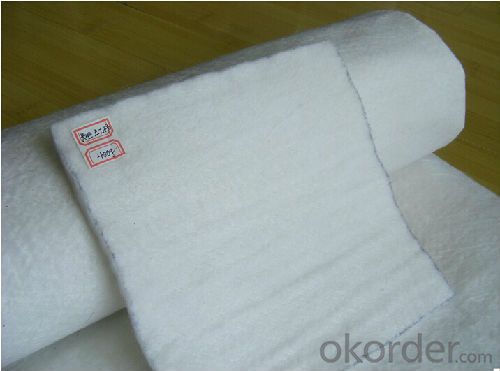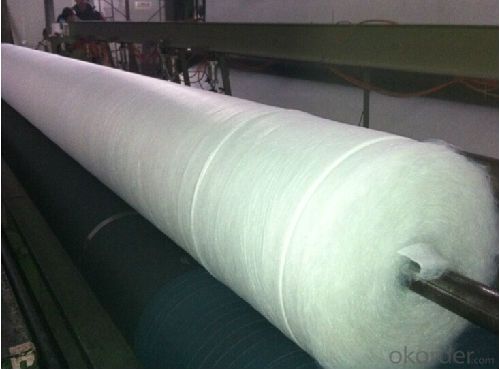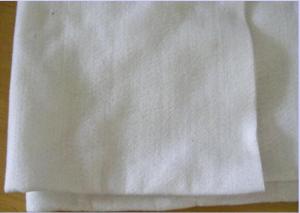100g-1000g Continuous Polyester Filament Spunbond Nonwoven Geotextile
- Loading Port:
- Qingdao
- Payment Terms:
- TT or LC
- Min Order Qty:
- 5000 m²
- Supply Capability:
- 300000 m²/month
OKorder Service Pledge
OKorder Financial Service
You Might Also Like
100g-1000g Continuous Polyester Filament Spunbond Needle Punched Nonwoven Geotextile
1.Product Specification for 100g-1000g Continuous Polyester Filament Spunbond Needle Punched Nonwoven Geotextile
Geotextile type: non-woven
Weight: 100gsm-1000gsm
Width: 1.0m-7.0m
Length: 50m-100m or as request
Color: White, black or as request
Certificates: ISO9001, ASTM, CE, SGS
2.Technical Sheet for 100g-1000g Continuous Polyester Filament Spunbond Needle Punched Nonwoven Geotextile
Item | Value | ||||||||||||||||||||
Nominal Breaking strength | 4.5 | 7.5 | 10 | 15 | 20 | 25 | 30 | 40 | 50 | ||||||||||||
1 | Breaking strength (MD/CD)/(KN/m) | 4.5 | 7.5 | 10 | 15 | 20 | 25 | 30 | 40 | 50 | |||||||||||
2 | Elongation at Break (MDD/CD) /% | 40~80 | |||||||||||||||||||
3 | CBR Mullen Burst Strength/KN | 0.8 | 1.6 | 1.9 | 2.9 | 3.9 | 5.3 | 6.4 | 7.9 | 8.5 | |||||||||||
4 | Tear strength/KN | 0.14 | 0.21 | 0.28 | 0.42 | 0.56 | 0.70 | 0.82 | 1.10 | 1.25 | |||||||||||
5 | Sieve Size O90/mm | 0.05~0.20 | |||||||||||||||||||
6 | Vertical Permeability Coefficient cm/s | K*(10-1~10-3) Among K=1.0-9.9 | |||||||||||||||||||
7 | Thickness /mm | 0.8 | 1.2 | 1.6 | 2.2 | 2.8 | 3.4 | 4.2 | 5.5 | 6.8 | |||||||||||
8 | Width Variation % | -0.5 | |||||||||||||||||||
9 | Weight Variation % | -5 | |||||||||||||||||||
3.Application for 100g-1000g Continuous Polyester Filament Spunbond Needle Punched Nonwoven Geotextile
1,Filter of embankment and slope protection of water conservancy projects, channel isolation, seepage control.
2,Isolate the basis of highway, railway, airport runway, filter, drainage, slope, retaining wall reinforcement, drainage and pavement.
3,Soft ground treatment of port engineering, beach, beach, harbor wharf and breakwater reinforcement and drainage.
4,Landfills, isolation of the ash dam, mine tailings dam in thermal power plants, the seepage control
4.Product Show for 100g-1000g Continuous Polyester Filament Spunbond Needle Punched Nonwoven Geotextile


5.RFQ
1) What's your payment terms?
L/C at sight, T/T are accepted
2) What's your package?
Per roll with one woven bag or as your request
3) What's your delivery time?
One week after prepayment received
- Q:How do geotextiles contribute to the environmental sustainability of construction projects?
- Geotextiles contribute to the environmental sustainability of construction projects by providing various benefits. They act as a barrier between the soil and construction materials, preventing erosion and sedimentation. This minimizes the release of pollutants into water bodies, thus protecting water quality. Geotextiles also help in stabilizing slopes and retaining walls, reducing the need for additional materials and resources. Moreover, they enhance soil drainage, reducing the risk of flooding and soil erosion. Overall, geotextiles promote sustainable construction practices by minimizing environmental impacts and preserving natural resources.
- Q:What are the factors affecting the selection of geotextiles?
- The factors affecting the selection of geotextiles include the type and severity of the application, desired performance characteristics such as strength and filtration properties, site conditions such as soil type and slope stability, environmental considerations such as chemical resistance and durability, and cost-effectiveness.
- Q:What are the advantages of using geotextiles in landfill lining systems?
- There are several advantages of using geotextiles in landfill lining systems. Firstly, geotextiles act as a barrier that prevents the migration of contaminants from the landfill into the surrounding environment. This helps to protect groundwater and nearby ecosystems from contamination. Secondly, geotextiles enhance the stability and integrity of the landfill lining system. They provide reinforcement and help to distribute the load evenly, which reduces the risk of structural failure. Additionally, geotextiles have excellent filtration properties. They allow for the efficient drainage of leachate, which is the liquid that is generated as waste decomposes. This helps to prevent the buildup of pressure within the landfill and reduces the risk of leachate seeping into surrounding areas. Furthermore, geotextiles are durable and resistant to degradation, ensuring the longevity of the landfill lining system. They are also lightweight and easy to install, which can save time and costs during construction. Overall, the use of geotextiles in landfill lining systems provides numerous benefits in terms of environmental protection, structural integrity, drainage efficiency, and cost-effectiveness.
- Q:Can geotextiles be used in rockfall protection works?
- Yes, geotextiles can be used in rockfall protection works. Geotextiles are often employed as a barrier or reinforcement material in these types of projects. They can help to prevent the displacement of rocks and soil, enhance the stability of slopes, and provide additional support to rockfall protection structures.
- Q:What are the standards and regulations for geotextile products?
- The standards and regulations for geotextile products are set by various organizations such as the American Society for Testing and Materials (ASTM), the International Organization for Standardization (ISO), and the Geosynthetic Institute (GSI). These standards cover different aspects of geotextile products, including their physical properties, mechanical performance, durability, and installation guidelines. Compliance with these standards ensures that geotextile products meet the necessary requirements for their intended applications and ensure the safety and reliability of their use in civil engineering and environmental projects.
- Q:Which big god has the relevant documents? bow down!
- Mainly from the anti-seepage, to prevent the role of soil erosion, I am specializing in the production of geotextiles, wish smooth
- Q:How do geotextiles help with filtration in wastewater treatment systems?
- Geotextiles help with filtration in wastewater treatment systems by acting as a barrier that separates the liquid from the solid particles. They allow the water to pass through while trapping and retaining the suspended solids, sediments, and other pollutants. This enhances the treatment process by improving the efficiency of filtration and preventing clogging or blockages in the system.
- Q:What are the environmental considerations of geotextiles?
- Geotextiles have several environmental considerations, including their potential to release microplastics into the environment, their impact on soil and water quality, and their potential for improper disposal. Additionally, the production and manufacturing processes of geotextiles may contribute to carbon emissions and energy consumption, further affecting the environment. Therefore, proper usage, disposal, and monitoring of geotextiles are essential to minimize their environmental impact.
- Q:Can geotextiles be used in river training works?
- Yes, geotextiles can be used in river training works. Geotextiles are often used to stabilize riverbanks, prevent erosion, and control sediment movement in rivers. They can be used to reinforce embankments, create slope stability, and protect riverbeds. Geotextiles are an effective and environmentally friendly solution for managing and controlling the flow of water in river training works.
- Q:Can geotextiles be used for reinforcement in retaining walls?
- Yes, geotextiles can be used for reinforcement in retaining walls. Geotextiles are commonly used in retaining wall construction to provide strength, stability, and improved drainage. They help to distribute the load and prevent soil erosion while allowing water to pass through, making them an effective solution for reinforcing and enhancing the performance of retaining walls.
1. Manufacturer Overview |
|
|---|---|
| Location | 示范:Hebei, China |
| Year Established | 示范:1997 |
| Annual Output Value | 示范:Above US$50 Million |
| Main Markets | 30.00% South America; 20.00% North America; 15.00% Eastern Europe; 15.00% Southeast Asia; 10.00% South Asia; 5.00% Southern Europe; 5.00% Africa |
| Company Certifications | ISO 9001:2008 |
2. Manufacturer Certificates |
|
|---|---|
| a) Certification Name | |
| Range | |
| Reference | |
| Validity Period | |
3. Manufacturer Capability |
|
|---|---|
| a)Trade Capacity | |
| Nearest Port | Tianjin;Qingdao;Shanghai |
| Export Percentage | |
| No.of Employees in Trade Department | 21-50 People |
| Language Spoken: | English;Chinese |
| b)Factory Information | |
| Factory Size: | Above 100,000 square meters |
| No. of Production Lines | Above 12 |
| Contract Manufacturing | OEM Service Offered;Design Service Offered |
| Product Price Range | High;Average |
Send your message to us
100g-1000g Continuous Polyester Filament Spunbond Nonwoven Geotextile
- Loading Port:
- Qingdao
- Payment Terms:
- TT or LC
- Min Order Qty:
- 5000 m²
- Supply Capability:
- 300000 m²/month
OKorder Service Pledge
OKorder Financial Service
Similar products
New products
Hot products
Related keywords
































